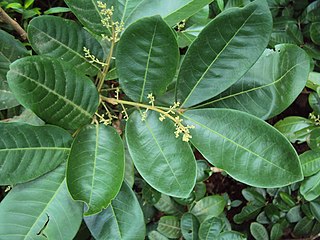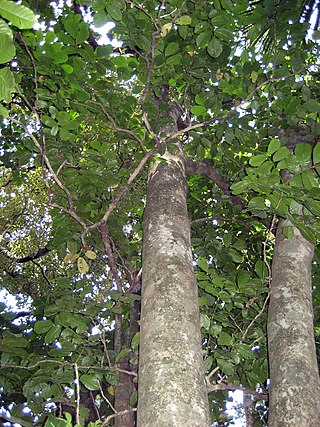
Meliaceae, the mahogany family, is a flowering plant family of mostly trees and shrubs in the order Sapindales.

The Solomon Islands rain forests are a terrestrial ecoregion covering the Solomon Islands archipelago.

Aglaia is a genus of 117 species of woody dioecious trees belonging to the Mahogany family (Meliaceae). These trees occur in the subtropical and tropical forests of Southeast Asia, Northern Australia and the Pacific.

Dysoxylum is a genus of rainforest trees and shrubs in the flowering plant family Meliaceae. About 34 species are recognised in the genus, distributed from India and southern China, through southeast Asia to Australia and the western Pacific. The name Dysoxylum derives from the Greek word ‘Dys’ meaning "bad" referring to "ill-smelling" and ‘Xylon’ meaning "wood".

Aglaia argentea is a species of plant in the family Meliaceae. It is a tree found in Australia, Brunei, India, Indonesia, Malaysia, Myanmar, Papua New Guinea, the Philippines, the Solomon Islands, and Thailand.
Aglaia brassii is a species of plant in the family Meliaceae. It is found in Australia, West Papua (Indonesia), Papua New Guinea, and the Solomon Islands.
Aglaia flavida is a species of plant in the family Meliaceae. It is found in Indonesia, Papua New Guinea, and the Solomon Islands.
Aglaia parksii is a species of plant in the family Meliaceae. It is found in Fiji, Papua New Guinea, and the Solomon Islands.
Aglaia parviflora is a species of plant in the family Meliaceae. It is found in Indonesia, Papua New Guinea, and the Solomon Islands.
Aglaia rubrivenia is a species of plant in the family Meliaceae. It is found in Papua New Guinea and the Solomon Islands.

Aglaia saltatorum is a species of plant in the family Meliaceae. It is found in Fiji, Niue, the Solomon Islands, Tonga, Vanuatu, and Wallis and Futuna Islands.
Aglaia sapindina is a species of plant in the family Meliaceae. It is found in Australia, Indonesia, Papua New Guinea, and the Solomon Islands.

Aglaia silvestris is a species of plant in the family Meliaceae. It is found in Cambodia, India, Indonesia, Malaysia, Papua New Guinea, the Philippines, the Solomon Islands, Thailand, and Vietnam. This plant initiated the naming of the Rocaglamide derivatives silvestrol and episilvestrol. In fact they were derived from the fruits and twigs of Aglaia foveolata.

Dracontomelon is a genus of flowering plants in the family Anacardiaceae, growing mostly in SE Asia and the Pacific islands. The fruit may be used in local cuisine, especially as souring agents.

Didymocheton is a genus of flowering plants in the family Meliaceae. It includes 41 species which range from eastern India through Indochina and southern China to Malesia, Papuasia, eastern Australia, New Zealand, and the South Pacific.

Didymocheton pachyphyllus is a small tree in the family Meliaceae, endemic to Lord Howe Island. It grows up to 15 m (49 ft) tall, and is found at all altitudes on the island.

Didymocheton pettigrewianus, commonly known as spur mahogany, spurwood, or Cairns satinwood, is a large tree in the family Meliaceae. It is native to the rainforests of Malesia, Papuasia and Queensland. In Queensland it occurs only in a small part of the northeast coast.

Chisocheton is a genus of trees in the family Meliaceae. The genus name comes from the Greek schizos and chiton meaning "split tunic", referring to the lobed staminal tube of C. patens. Their range is from India and tropical China, throughout Malesia and south to New South Wales and Vanuatu.
Prasoxylon alliaceum is a tree in the family Meliaceae. The specific epithet alliaceum is from the Latin meaning "onion-like", referring to the smell of the inner bark.
Didymocheton mollissimus is a species of tree in the family Meliaceae. It ranges from eastern India and Bangladesh to southern China, Myanmar, Thailand, Peninsular Malaysia, Borneo, Sumatra, Java, the Lesser Sunda Islands, and the Philippines, where it grows in lowland tropical moist forests.









